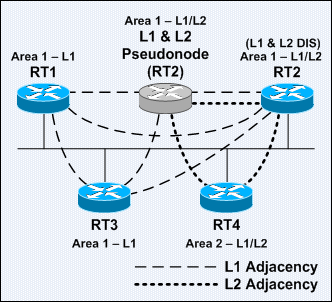IS-IS L1 and L2 Adjacencies over a Broadcast Network
Figure above shows a LAN attached with routers from 2 areas.
- L1 routers from one area accept L1 IIHs only from their own area and therefore establish adjacencies only with other L1 routers reside in their own area (RT1, RT2, RT3).
- L1 routers reside in another area establish adjacencies using L1 IIHs of their own area.
- L2 routers (or the L2 process within an L1/L2 router) reside in the same or different areas establish only L2 adjacencies using L2 IIHs.
L1 and L2 IIHs share a common format on point-to-point WAN links.
The area address and router type (L1 or L2) are announced in the IIHs.
- 2 L1 routers in the same area (which includes the links between L1 and L1/L2 routers) exchange L1 IIHs and establish an L1 adjacency.
- 2 L1 routers from different areas do not establish an adjacency.
- 2 L2 routers (in the same area or between areas, including the links between L2 and L1/L2 routers) exchange L2 IIHs and establish an L2 adjacency.
- 2 L1/L2 routers in the same area establish both L1 and L2 adjacencies using L1 and L2 IIHs.
- 2 L1/L2 routers from different areas establish only an L2 adjacency using L2 IIHs.
IS-IS Adjacency Matrix over Point-to-Point WAN Links


No comments:
Post a Comment